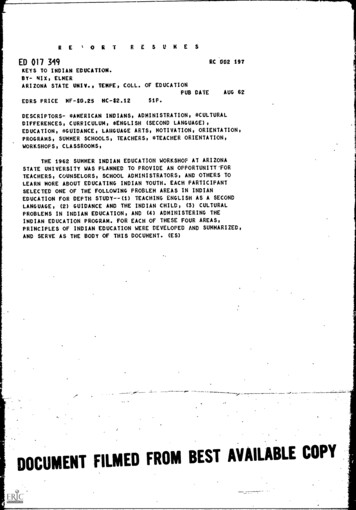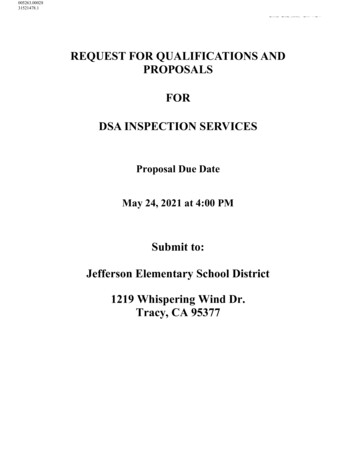
Transcription
REIORT RESUMESED 017 349RC 002 197KEYS TO INDIAN EDUCATION.BY- NIX, ELMERARIZONA STATE UNIV., TEMPE, COLL. OF EDUCATIONPUB DALE51P.EDRS PRICE MF- 0.25 HC- 2.12AUG 62DESCRIPTORS- *AMERICAN INDIANS, ADMINISTRATION, *CULTURALDIFFERENCES, CURRICULUM, *ENGLISH (SECOND LANGUAGE),EDUCATION, *GUIDANCE, LANGUAGE ARTS, MOTIVATION, ORIENTATION,PROGRAMS, SUMMER SCHOOLS, TEACHERS, *TEACHER ORIENTATION,WORKSHOPS, CLASSROOMS,THE 1962 SUMMER INDIAN EDUCATION WORKSHOP AT ARIZONASTATE UNIVERSITY WAS PLANNED TO PROVIDE AN OPPORTUNITY-FORTEACHERS, COUNSELORS, SCHOOL ADMINISTRATORS, AND OTHERS TOLEARN MORE ABOUT EDUCATING INDIAN YOUTH. EACH PARTICIPANTSELECTED ONE OF THE FOLLOWING PROBLEM AREAS IN INDIANEDUCATION FOR DEPTH STUDY--(1) TEACHING ENGLISH AS A SECONDLANGUAGE, (2) GUIDANCE AND THE INDIAN CHILD, (3) CULTURALPROBLEMS IN INDIAN EDUCATION, AND (4) ADMINISTERING THEINDIAN EDUCATION PROGRAM. FOR EACH OF THESE FOUR AREAS,PRINCIPLES OF INDIAN EDUCATION WERE DEVELOPED AND SUMMARIZED,AND SERVE AS THE BODY OF THIS DOCUMENT. (ES).,COPYAVAILABLEBESTFROMDOCUMENT FILMED
TOINDIANEDUE ATION
U.S. DEPARTMENT OF HEALTH, EDUCATION & WELFAREOFFICE OF EDUCATIONTHIS DOCUMENT HAS BEEN REPRODUCED EXACTLY AS RECEIVED FROM THEPERSON OR ORGANIZATION ORIGINATING IT.POINTS OF VIEW OR OPINIONSSTATED DO NOT NECESSARILY REPRESENT OFFIC'AL OFFICE OF EDUCATIONPOSITION OR POLICY.KEYS TO INDIAN EDUCATIONIndian Education WorkshopSecond Session Summer SchoolBE - 5221962Indian Education CenterCollege of EducationArizona State UniversityEdited byElmer Nix
INTRODUCTIONThe 1962 Indian Education Workshop was planned to provide an opportunityfor teachers, counselors, school administrators and others interested in theproblem of Indian Education to share ideas and experiences in this field, andthrough reading, study, attending lectures, and participating in small groupseminars, to identify and clarify the basic concepts and principles fundamental to effective teaching and guidance of Indian children, and to administration of educational programs for Indians. Each workshop participant was givenan opportunity to share ideas and experiences in one or more interest areas.Those who were primarily interested in a better understanding of the Indianchild and his cultural heritage, formed a special group to study the effectsof cultural difference in teaching. Others studied such problems as teachingEnglish as a second language, guidance and the Indian child, and administeringthe Indian Education program.ORGANIZATION OF THE COURSEThe Workshop was held during the second term of the 1962 Summer Session.Balf.day sessions were held daily, Monday through Friday, beginning at 7:40 a.m.and continuing until 12 noon. Although there was considerable flexibility,each session generally followed this schedule:7:40 - 9:00 Lecture and/or preparation for guest speaker9:00 - 9:15- -.- Break9:15 - 10:30 - - Guest speaker and/or panel discussion10:30 - 10:45 - Break10:45 - 12:00 - - Small group conferences and seminars to levelop basicprinciples in Indian Education.Many distinguished and outstanding people appeared as lecturers and resource persons during the session. The 9:15 to 10:30 and 10:45 to 12:00 periods during the last week, were devoted to group reports in the form of paneldiscussions. Each group was given ample time to summarize the groups accomplishment. The Principles of Indian Education developed in each problem orintcmst area were discussed by the pant/ members and copies of statements ofprinciples made available to all workshop participants.Each participant selected one of the following problem areas in IndianEducation for depth study:1.2.Teaching English as a Second LanguageGuidance and the Indian Child3. Cultural Problems in Indian Education4. Administering the Indian Education ProgramFour working groups were formed. Some who were interested in more than onearea participated in seminars with other groups, however, they were requiredto designate one problem area as an area of conz.entration and dad sake theirsaaximum contribution to the group working in that area.Individual case studies or written reports were not required. The aim ofthe workshop was to develop some Principles of Indian Education that would be
useful to teachers, guidance workers and administrators in schools with Indianchildren. A group process method was used. For example, the group working inthe area of Guidance and the Indian child reviewed the available literature,consulted with tribal leaders, guidance specialists, educational specialists,Indian students and other resource persons to determine definite and positiveprinciples of guidance that could be stated and clarified. Other groups wr-kedin a similar manner. The principles of Indian Education that were formulateuare given in this manual which we have titled, "The Keys To Indian Education."Elmer Nix, DirectorIndian Education Workshop
CONSULTANTSMr. Paul Bram let, Area Director of SchoolsPhoenix Area OfficeBureau of Indian AffairsMr. Maurice GammenDirector of Indian EducationArizona State Department of Indian EducationMr, Donald Fosdick, Educational SpecialistPhoenix Area OfficeBureau of Indian AffairsDr. Charles BernardoniGuidance SpecialistArizona State Department of Indian EducatioiMrs, Grace Blossom, Reading SpecialistCortez High SchoolGlendale, ArizonaMk. Delbert JeromeGuidance Specialist & Graduate AssistantArizona State UniversityMr. Eugene PrevittGuidance CounselorChinle Public SchoolEX, Nelson Jose, GovernorGila River Pima-Maricopa TribeSacaton, ArizonaMrs. Myra Rice, Vice ChairmanSalt River Pima-Maricopa TribesMesa, ArizonaHr. Marvin Mull, ChairmanSan Carlos Apache TribeSan Carlos, ArizonaMr. Ralph Wiseman, PrincipalSalt River Indian Day SchoolMr. J. D. Sykes, Educational SpecialistBureau of Indian AffairsSacaton, ArizonaMrs. Catharine M. Iliff, Teacher,Phoenix Indian SchoolPhoenix, Arizona
Mrs, Mamie Sizemore, Curriculum SpecialistArizona State Department of Indian EducationPhoenix, ArizonaMrs, Juanita Potts, SupervisorOsborn Elementary School SystemPhoenix, ArizonaMr. Raymond Enos, MemberEducation Committee,Salt River Pima-Maricopa TribeWs. Ruth E. Jones, Former teacherBIA and Public SchoolsMr. Enoch Walkingstick, TeacherSalt River Day SchoolMrs. Clara Walkingstick, TeacherSalt River Day SchoolMr. Philip Perales, TeacherSalt River Day SchoolMrs. Ethel Rowe, TeacherSalt River Day School
WORKSHOP PARTICIPANTSAnn BennettElmer H. AndersonCoulee Dam, WashingtonNursing Education OfficerPHS Indian HospitalPhoenix, ArizonaFather Jude C. Reutten, 0.FX,St. Johns Indian SchoolVictoria Harris1329 E. Mitchell DriveEducational SpecialistColville Indian AgencyLaveen, ArizonaPhoenix, ArizonaEthel Strantz, TeacherMaude 11, Xi Mean, TeacherLincoln SchoolPhoenix Elementary No, 1Phoenix, ArizonaLincoln SchoolPhoenix ElementaryPhoenix, ArizonaNo. 1Elizabeth It. Smith, TeacherLincoln SchoolPhoenix Elementary No.Phoenix, ArizonaBrother Martin Soto, O.F.M.St. Johns Indian SchoolLaveen, ArizonaEsther Beatrice Crane, TeacherSusan J. Nix, Teacher0. C. Johnson SchoolYuma, ArizonaErni ley Pedersen, TeacherJohn E. Long SchoolPhoenix, ArizonaBillie Sue Farmer, TeacherEast Junior High SchoolMaricopa High SchoolMaricopa, ArizonaMesa, ArizonaGlenn Wessel Meek, TeacherKayenta Public SchoolKayenta, ArizonaGlobe High SchoolGlobe, ArizonaWilmot Irvin Bidner, Teacher936 Maple AvenueTempe, ArizonaMohave Elementary SchoolScottsdale, ArizonaDale Sanderson, TeacherCortez High SchoolGlendale, ArizonaLisbeth Eubank, Principal-TeacherNavajo Mountain Community SchoolBureau of Indian AffairsTuba City, ArizonaShirleyJones, TeacherEmily Jacobs Borges-SylvaRose Kyznarich, TeacherSan Pasqual High SchoolWinterhaven, Arizona
PREFACEThe Indian child enters school with a totally different cultural conceptto that of his English speaking peer. He speaks and thinks in a primitivelanguage. Therefore it is doubly hard for him to learn a new language becausehe must master it, not in terms of the old, as we might learn Spanish, but assomething entirely apart from it. The three basic Indian dialects are most difficult for the English speaking teacher to learn,The Indian child will learn English if he finds a need for it.most promote that need through motivation, One thing in our favor,that we can make an early start during the developmental stage whenspeech patterns and habits have not been too deeply established andWith a fair command of words, writing and spelling will follow at aTeachersis the factthe child'singrained.rapid pace.To facilitate and accelerate this chain of learning processes is one of themajor purposes of the language program. So, with the many, handicaps of theteacher in mind, we have attempted to set up a series of principles that willmore or lesa serve as. guideposts in an approach to teaching English as a secondlanguage.
THE TEACHER OF INDIAN CHILDREN MUST REALIZE THS IMPORTANCE 07 HELPING THEM TO DEVELOP A GOOD VOCABULARYand receive1. Communication is our most important tool, for through it, we giveexperiencesinformation. Language is developmental because it is based on life'sand education, The bilingual child is handicapped because his educational expeoften cosriences are limited; thus, his educational growth is retarded. He hasmunicated in his native tongue and may still think in it. He %111 need many opportunities for growth. In the four aspects of language, which are: speaking,reading, writing and spelling. His achievement in language is the basis forsuccessful adjustment to school life.The purposes of the English program include instruction to enable the child(1) Interpret What he bears and sets and what goes on about him in terms ofto:intelligent thought, speech and writing. (2) To express his own ideas, (3) Touse with ease and assurance the conventional forms of speech appropriate to thesituartons he encounters, (4) To pronounce words correctly, enunciate clearly,use the cadence and intonation to which American ears are accustomed.2. The climate of the classroom, to be conducive to learning, must be geared tothe characteristics of the Indian Child's personality. He must be happy, interested and have stimulating experiences to progress.Lacking initiative, the Indian child is more comfortable in a group settingwith a leader (teacher) to tell him exactly what to do and when to do it. Heprefers to be in an atmosphere of sharing.Sensitive to the criticism of others and fearing ridicule and/or shame, thechild may be withdrawn and appear unduly shy. Hire, again, working in a grouphas its advantages.The Indian child does not readily talk to strangers, so the teacher mustmake him emotionally safe and secure in the classroom.Having no value placed on time, be must be made aware of the fact that heis slowly but surely progressing through a day in a happy orderly wanner.Interested only in the here end now, the Indian child rust be led into thoseactivities that are meaningful to him day by day.Having warmth and affection at home, he instinctively seeks warm human relationship at school. The teacher's attitude bridges this gap and the behavioris predetermined. She is as uuch a part of the favorable climate of the classroom as are the physical aspects of the room,3. Due to the particular characteristics of the type of culture from which becomes, the goals of the Indian child should be immediate, tangible and geared tohis rate of learning so that he may experience a feeling of accomplishment and asense of belonging.The achievement levels of these children will doubtless remain below theacademic standards attained by his white neighbor due to the language barrierand lack of background. He will progress best in an atmosphere of teacher understanding, friendliness and guidance and in a program of flexible instruction.-1-
4. Only by gaining a broad view of the individual as he functions in all hisinter-personal relationships, can we have a starting point toward the teachingof English.When we truly understand the attitudes and values which motivate the Indianchild's behavior, we can make progress in teaching him. This can be done byfinding out as much as possible about the tribal customs of the group. Sincereand dedicated interest has solved many "insoluble" problems.Growth in learning the English language is much faster for the Indian childif English is taught parallel to she child's'native tongue.5.On the reservation, English is used only in dealings with the non- Indians -traders and missionaries who move into the Indian world. The truly bilingual isequally at home and familiar with two languages. Very little primary readingmaterials deal with experiences that are familiar to Indian children.The arts,---music, poetry, dance, ceremonials and folklore are still contemporary, wholly alive and vital. Much of this can form a sound basis forliterature.Teaching the English language to an Indian child must, of necessity, be aslow, methodical process.6.Indian children, properly trained, can do all that a white child can do, Ina mental test he is more careful and accurate, but not as quick as his whiteclassmate. He is not inferior intellectually, but he does learn slowly and thusgives an impression of mental deficiency. As the language barrier is decreased,the academic level will increase.Not only is tine an important element in teaching the Indian children tospeak well, but patience is equally important. By patience, the teacher willprovide many and varied opportunities for the children to practice their secondlanguage. An impatient teacher has driven many an Indian child away from spcelting English, Be has forgotten that he crawled before he walked, that he mispronounced words before he spoke correctly.7. An Indian child who has been reared in a culture which teaches that childrenshould remain silent when in the presende of elders, should not be expected torespond readily in classroom situations.Teachers easily criticize Indian children for being different from what iscurrently "socially acceptable" without understanding the reason for the difference. If the pupil is hesitant about talking, the teacher should try to findout the reason, whether it be Cultural background, timidity, lack of Englishvocabulary or just stubborness. The latter is very seldom the case. More often,it is failure to understand what is expected of him since he has been taught inhis home to be "seen and not heard" unless he is directly spoken to,Indian children differ from non-Indian children, not because they are retarded in maturing, but because of their experiences. Theirs is a very different culture. The Indian child needs to be exposed to experiences, situations,and ideas in school that are basic to the dominant culture.-2-
8. To insure good listening habits, which is a forerunner to speaking, theteacher must build a program around the immediate interests of the children.The first words learned in any native tongue are acquired by hearing themrepeated over and over in connection with meaningful situations, We use thevocabulary we have learned whenever we feel a need for it, to make our wantsknown, or to express our ideas. So, learning English should be built upon thatprinciple. The phrases that children need to use should be taught immediately.The listening period should be short, due to a limited interest span.Pronunc'ation, vowel sounds, consonant sounds and dipthongs are all firstlearned through imitation, The teacher should set up drills and practices andsupervise the transition from controlled drill to meaningful speech.9. In teaching Indian children English as a second language, the use of abstractions, similes, idiomatic expressions and slang should be avoided.The Indian child cannot grasp the meaning of expressions with which he hasnot had actual experiences. A theory, a comparison, an emblem, a visionarynotion or idioms are completely foreign to him unless he comes directly in contact with the real object.An example: The teacher, in crying to motivate a youngiter to improve hisdaily work habits by a good "pep" talk, ended the conversation by saying "Nowlet's get on the ball and get the work done." The child was more puzzled thanever and began looking all about for the ball to get on.The teacher needs to fully comprehend the meaning of idioms and the situations in which they can be appropriately used, because many times such languageis often grammatically inconsistent or illogical in meaning.10. Due to the limited background of the Indian child, he must have a longer enrichment period of reading readiness.Activities and experiences should center in tangible things,---things thatcan be seen, heard, touched, tasted and smelled. Reading materials should bebased on what the child can understand and for which he has a proper concept.The story or poem about "Baa, Baa, Black Sheep" or "Mary Had a Little Lamb"would more readily motivate Indian children to want to learn than a Story orpoem about a ten story building in New 'fork or the subways of London.Actual excursions to the scene of an activity aid the Indian child. Filmsand pictures are of help. The Indian child is more affected by experience thanby verbalization.11. A child's vocabulary is developed through imitation, practice, response, reinforcement listening, and through use of the language in natural structural andintonation patterns.The learner must develop accurate habits of hearing and reproducing theEnglish phonetic system with a minimum of interference from his native language.The teacher should know the sounds in the English language that do not exist inthe child's native tongue because these are the sounds that are difficult forhim. For aural training, the pupil must listen to the instructor, then say thesentence to himself and to classmates. Much help can be given the child if the3.
placed to produceteacher speaks distinctly, showing just where the tongue isHowever,the desired results. The word Mother is often pronounced "mudder",that he canwith guidance on placing the tongue properly, the child soon learnssay "Mother".excellent in teaching the12. Sentences and words concerned with action arewith a controlledIndian child a second language, providing they are introducedvocabulary.Let's use a true illustration where the teacher was teaching "Close thethe exactdoor," The sentence was made meaningful as long as it was stated in"Go shutwords. A different wording was used, either purposely or by mistake.be moved towardthe door," came the command, which baffled the child. Hesitant,the door, because the word door was familiar to him. Instead of closing thehard. Feeling verydoor, he looked at it for some time, then kicked it good andThis kind ofpleased with himself, he returned to his seat, smiling proudly.thing can be very confusing.The following initial activities provide a medium for spontaneous(A)speech.1. Caring for a pet.2.3.4.5.6.Planting a garden.(Sewing, care, harvesting and eating)Cooking something simple.Working with clay.Simple weaving.Interest centers.a. Play center with appropriate toys.b. Music center with record player and records.c. Library center for picture books.d. Health center for mirror, combs and soap.Follow-up activities to improve his articulation and increase his language ability must progress slowly from the known to the unknown,(11)1.2.3.4.5.Experience charts depicting his home life and the activities he participates in with family and friends.Development of right social habits, such as politeness. (Please andthank you).Story telling by the teacher with the children repeating the refrain.These may be aided by using flannel board characters, puppets, colorfulpictures from magazines or by the teacher sketching on the easel.Pronunciation helps, such as talking on the telephone, vocabulary andnumber cards, scrapbooks, pictures in sequence, action singing with therecord player.Matching objects and naming them.6. Counting.7. Choral reading. The child will respond to the goods of the story,8.emphasizing expression where needed. Timid children overcome timidityand all will develop a better sense of rhyme and rhythm. Poetry isvaluable for practicing pronunciation skills because of the rhymingrepetitions,Dramatization. Simple poems are a good start. The child learns co-operation and teamwork, because he can forget his shyness by pretending tobe another character. He learns to project his voice and to detect the-4-
rhythm of the language through power, intonation, pauses and stress.(C) Play fulfills many of the basic needs because it is a means of expression and communication. The term "Play" has many facets, any of which promotesan informal atmosphere for happy conversation. Note the following:1. Learning handcraft skills. He learns to name and care for equipment.This promotes orderliness and self discipline, something he has neverexperienced. His senses of touch and smell are quickened and be developseye and hand co-ordination. He must be encouraged to repeat the thingshe likes to do, and naturally does well. Out of rtall beginnings, comeinterests in the priceless craftwork of his peop7a, --something we mustinstill in him en interest and appreciation for. The vocabulary acquiredcovers a wide field. Playing with color, weaving and clay craft, somehammering and sanding will all one day be tools of his trade.2. Singing is an expressive experience. Group singing is a feeling ofsharing. Singing to the and of a song increases attention span. Ithelps to develop vocabulary and word meaning sense, He must have simplefamiliar songs about things he doei or sees other people do, the thingsbe loves, attitudes he uaderstands. Co-ordinate his ability to think,speak and act by having as many action songs as possible. The importantpart is to teach him to listen fitst.Organized games: Games have rulec that must be understood and adheredto. In society he must: be prepared to abide by rules and follow a leader. (This is foreign to his make -up). Here is a situation for thehappy give and take in conversation,4. Visual Aid materials: Records, film strips and films feature in bothstory telling and dramatics. This play activity, more than any other,is truly the heart of expression.13. Tests should be used only to indicate to the teacher the instructional needsof bilingual children and not necessarily to find out how much they know.It is diffidult to test a child just learning to speak English. Only culture4ree tests thoUld be used.A test should use pictures or objects familiar to the student. Since thismust be an oral test, directions given with clear enunciation and pronunciationcan achieve desired knowledge of how much English the child has actually learned.For example, we use the doll as the object. The teacher can say, "Touchthe doll's hands --dress---bair--eyemetc." "Hold the doll up high." "Putthe doll on the floor." "Let the doll stand alone." Most of the children havedolls and a test given in this manner will be a valid test for the teacher who issearching for instructional needs. Teacher observation is a much better gaugethan most tests.14. Indian pupils, having learned the rudiments of the English language in theprimary and the elementary grades, should be encouraged to strive for higherlevels of communication through the motivating power of pride; pride in racialaccomplishment and pride in the development of modern-minded Indian leaders.
It is the task of the English teacher to make known the desirability andadvantages to the child of knowing the English language. Success itself Will bea powerful reinforcement to further study. The parents Will feel a certain prideat the linguistic achievement of their children.The Indian child allot be given a great deal of oral practice so that thecorrect pronunciation will become fixed in his memory. This oral practice willprovide for aural comprehension and will lay the groundwork for reading and writing. Thus, the teacher must formulate formal drill sessions for the sake ofpracticing certain conversations or pronunciation of phrases or words. Specialcare should be given to correct sentence structure, Speech patterns will resultonly if proper sentence formation is known. As adults have learned to do mostthings by some activity, so the child will become proficient in language only bynpeaking.It is the teacher's own responsibility to see that the child hears only correct speech. To master a language, it is not necessary to read it. But it isextremely doubtful whether one can really read the language without first mastering it orally. Practice will make perfect; but it must be perfect practice.If an Indian child cannot imitate the speech sounds he hears, the teachermust search carefully for the cause of failure with special regard to the use thechild makes of his speech organs.15.Indian children, like any other children, are physically capable of reproducing all the English sounds, Every language, it is true, has it own peculiarsounds. But with a little care the teacher can hear when the Cie' t-t substituting a similar sound from his own language for a comparable Ens1 ,.4 sound. Byworking together in front of a mirror, both teacher and student can helpfullyobserve each other. Failure to eliminate faulty pronunciation and enunciationas soon as it is observed will easily result in speech delivery that is perms.neatly poor.16. Abundant use of oral work stimulates the child's confidence and enables theteacher to keep track of the child's thinking processes.The confidence gained from learning a language properly has far reachingsocial and cultural consequences which facilitate the students'eventual adjustment to the dominant society about him. Someone has said that one does not reallyunderstand an ieee unless he can put it into words. The teacher has the responsibility of teaching Indian children the exact meaning of idiomatic expressions.Anyone who has studied a language other than his own, readily realises how difficult it is to translate an idiom from one language to another. It is essentialthat the Indian child be thoroughly instructed in the exact meaning of languagepatterns proper to English. And here, both similarities and contracts must bedisplayed that the Indian child appreciate both English and his native tongue.17. The teacher of Indian children, must provide numerous opportunities for repetition and drill in the English language.The children will glady respond in choral and individual responses if theteacher makes speech exercises meaningful and useful, Conversation about everyday life about situations which the child understands will encourage his uoe ofEnglish. Many mental blocks are formed in the Indian child because much of theculture in which he finds himself is unfamiliar to him, It is imperative that theteacher endeavor to use those situations known to the child if his knowledge ofthe English language is to progress. He will soon experience the pleasure ofaccomplishment, and be motivated by encouragement from the teacher.-6.
C w ItsocdInProblemstwiapi., rchicomniaMeetrni of The old wild441y. 0 u 111r) Qv"lin cler eta Nn 4 *4 yl 5
PREFACEThe state of Arizona has shown a concern for the education of the Indianchildren within its state confines. By passage of two Federal laws, Public Law#815 and #874--one covering the cost of the buildings and facilities, the othercovering the cost of educating Indian children, more Indian children are attending public schools. The school program heretofore has followed a sterile path-making little contact with the tribal experience or the actual reservation environment of the Indian child. A school program is only valid when it satisfiesthe needs of the people being educated. It is up to the educators to discern andperceive these needs. As David Reisman says, "to perceive something is what youare going to do about it,"The educational philosophy of the state of Arizona comes from a total ofprinciples by which men live and from the interacting social policy which guidesthem. Our social policy is Democracy. Democratic living can be achieved bydemocratic participation. Each individual is unique and capable of some contribution. As each individual realizes and exercises his own worth, society willbenefit, and the good of the whole is manifest. Schools are the tools of societywhereby we as educators help the child to make the adjustments to a complex andChanging society. We have mobility and an interdependence of peoples. We havea great need to accept, associate, and work together. The principles of Education should be concerned with problem solving, adjustment to change, opportunityfor self-expression and creativity, and an understanding of the interdependenceof peoples. Since the above "freedoms" are assured under the Arizona State Constitution there should be no problem involved as to the education of the Indianchild, Yet, it is in the cultural differences that we find our area of difficulty.Cultural differences are manifest in attitudes, ideals and beliefs deeplyensconced in the language, culture and evparience background which nourish theretardation of any minority group. In our drive for a "one world" we are deeplyconcerned with the dignity of man. Whatever the slant of his eye or the shape ofhis nose, he is a human being -- one of the great brotherhood of man. Commonunderstandings between men of different cultures are very broad. They are oftenobscured by language and the external trappings of custom, yet the common humanity is evident.Culture is the man-made part of one's environment. It is socially transmitted to others within the group. It is fed and nourished on ritual, mores, precedent and tradition. It is composed of many elements that are easily discernableand recognised. Food, clothing, arts and crafts, housing, mythology, religion,social and political systems and languages are constituents of culture, generallyobserved. But there is more to culture than meets the eye. In this area, valuer,are
teachers, counselors, school administrators, and others to learn more about educating indian youth. each participant selected one of the following problem areas in indian education for depth study--(1) teaching english as a second language, (2) guidance and the indian child, (3) cultural problems in indian education, and (4) administering the









